Asian Vine Snake
Ahaetulla prasina
This snake chews on its victims to release venom.
Advertisement
Asian Vine Snake Scientific Classification
- Kingdom
- Animalia
- Phylum
- Chordata
- Class
- Reptilia
- Order
- Squmata
- Family
- Colubridae
- Genus
- Ahaetulla
- Scientific Name
- Ahaetulla prasina
Read our Complete Guide to Classification of Animals.
Asian Vine Snake Conservation Status
Asian Vine Snake Facts
- Prey
- Frogs, lizards, insects, small birds
- Main Prey
- Frogs
- Name Of Young
- Neonate or snakelets
- Fun Fact
- This snake chews on its victims to release venom.
- Estimated Population Size
- Unknown
- Most Distinctive Feature
- Pencil-thin body
- Distinctive Feature
- A spear-shaped and pointed head
- Other Name(s)
- Gunther’s whip snake, Oriental whip snake, Boie’s whip snake
- Diet
- Carnivore
- Common Name
- Asian vine snake
View all of the Asian Vine Snake images!
The Asian vine snake’s long, thin tongue resembles a worm that can lure in frogs and other prey.
The Asian vine snake is native to Southeast Asia and lives in a forest habitat. This snake is notable for its bright green scales and a body the width of a pencil. It’s venomous with a diet of frogs and lizards. The population of this snake is stable and it’s listed as Least Concern by conservationists.
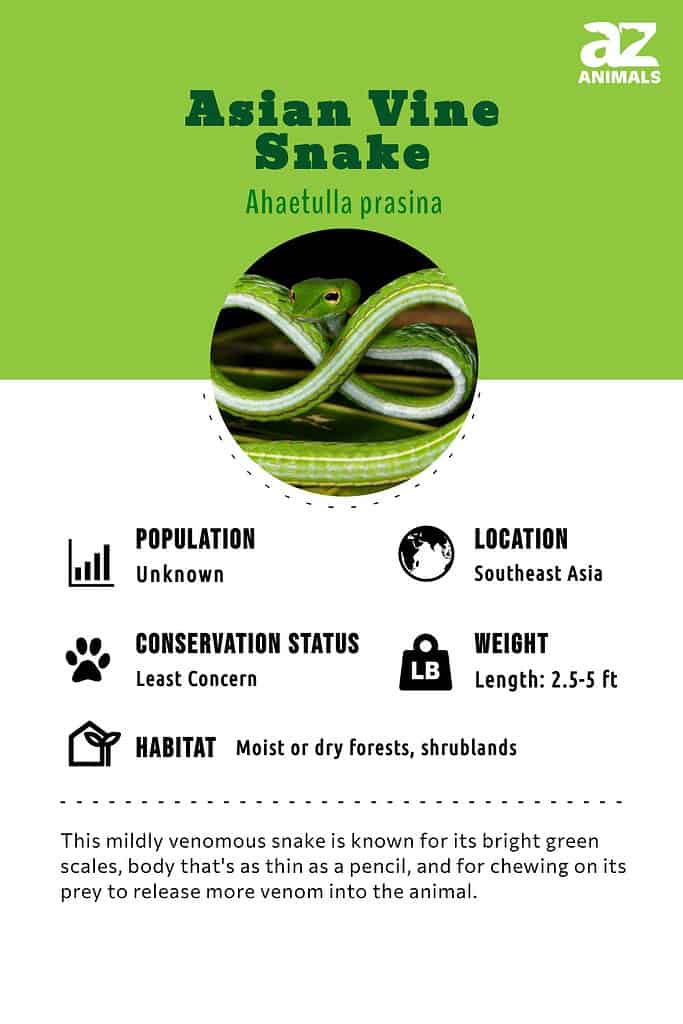
4 Amazing Facts About the Asian Vine Snake
- It gives live birth to as many as 12 neonates, also known as snakelets.
- Along with striking its prey, this snake chews on it to release venom.
- Its body is the width of a pencil.
- Its green scales are so bright they can sometimes appear to be fluorescent.
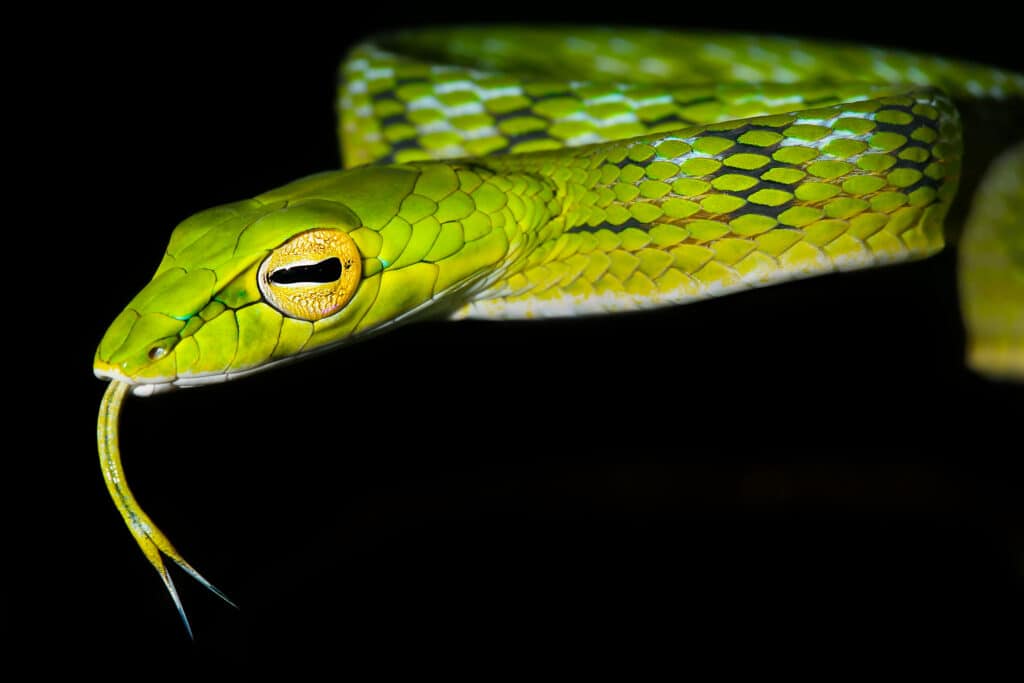
Asian vine snakes’ green scales can look fluorescent.
©Ryan M. Bolton/Shutterstock.com
Scientific Name
Ahaetulla prasina is the scientific name of the Asian vine snake. The Latin word prasina translates to leek green. It’s a member of the Colubridae family and the Reptilia class.
Other common names are Gunther’s whip snake, Boie’s whip snake, Oriental whip snake, and Jade vine snake.
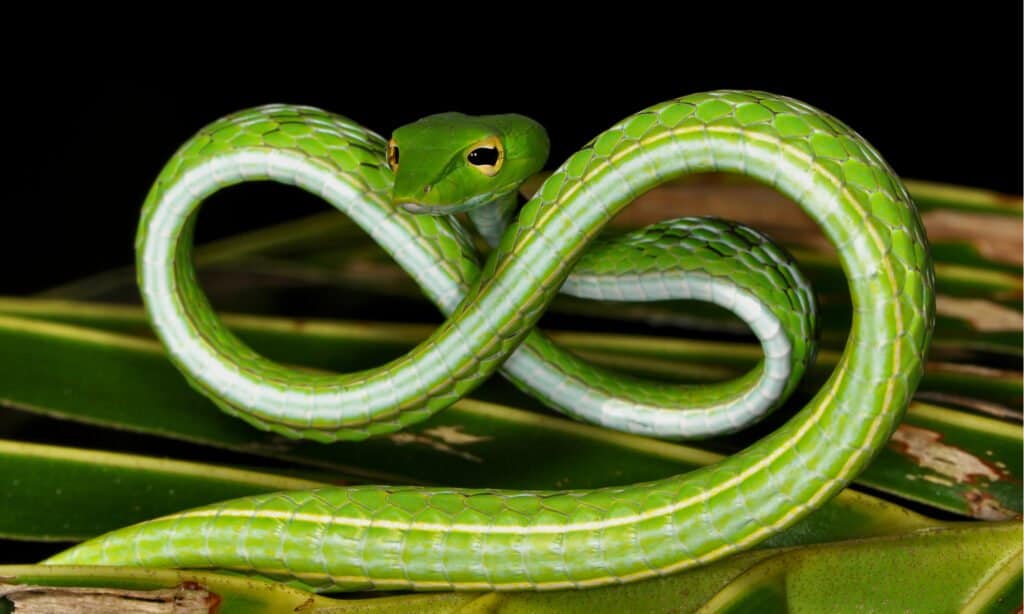
Common names for the Asian vine snake include Gunther’s whip snake and Oriental whip snake.
©Ferdy Timmerman/Shutterstock.com
4 Types of Asian Vine Snake
While there is limited data available on different types of Asian vine snakes, scientists have recognized four subspecies of this snake. The subspecies are:
- Ahaetulla prasina medioxima
- Ahaetulla prasina preocularis
- Ahaetulla prasina prasina
- Ahaetulla prasina suluensis.
Although this snake is sometimes referred to as a green vine snake, it is not Oxybelis fulgidus, the green vine snake species that is present in Central and South America.
Other similar animals include the red racer snake, twig snake, and Mandarin rat snake.
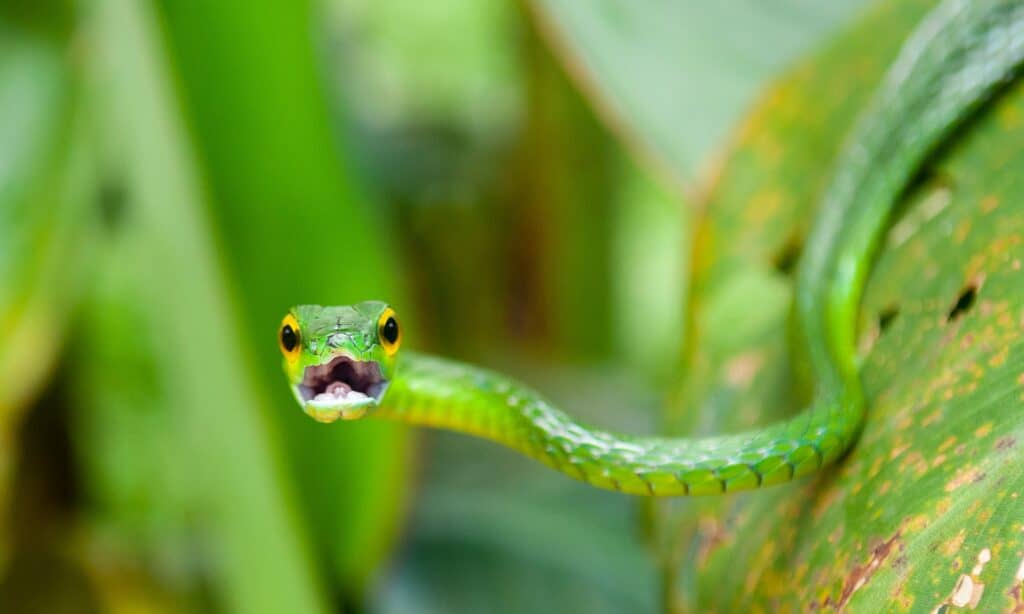
The Asian vine snake is a different species from the green vine snake found in Central and South America.
©iStock.com/SL_Photography
Evolution and Origins
The Asian vine snake belongs to the genus Ahaetulla, colubrid snakes found throughout tropical Asia. Ahaetulla split from the monotypic genus Proahaetulla in the middle of the Oligocene epoch, which was 33.9 million to 23 million years ago.
Asian vine snakes are thought to have adapted to their environment in several ways. These snakes are believed to have evolved in their colorations, becoming lighter in order to deflect heat from their bodies in their tropical habitats. They are also said to have developed thicker skins that hold onto moisture and keep them more hydrated in dry climates, and during droughts and extremely high temperatures.
While many other snake species only hunt during the night, the Asian vine snake also hunts during the day, and it’s likely that this evolution is due to there being reduced competition for food sources during the day. This species also has a prehensile tail that allows it to grip onto branches in its environment, a possible adaptation from spending so much of its time in trees and on vines high above the ground.
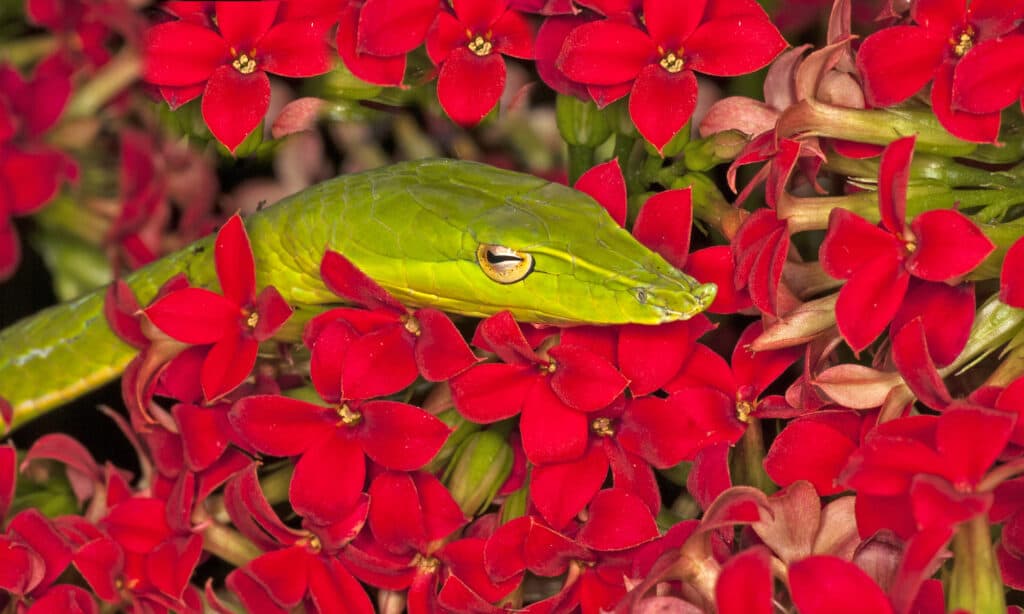
It’s thought that the Asian vine snake evolved to have lighter-colored and thicker skins.
©Rosalie Kreulen/Shutterstock.com
Appearance and Description
The Asian vine snake has bright green scales. Some of these snakes have a yellow stripe on their back while others have a pattern of blue lines running through their scales.
The head of an Asian vine snake is pointed and has been compared to a spear. If you study the shape of this snake’s head, you’ll notice a bump on both sides at the back of its head. These bumps contain the venom glands of this snake.
One of the most interesting facts about this snake’s fangs is they’re located in the back of its mouth. Each fang is grooved so when the venom drips from its venom glands, it runs down the groove of its fangs.
The width of this snake’s body is similar to a pencil. Its length ranges from 2.5 to 5 feet.
These snakes have a vertical black pupil in each of their yellow eyes. This feature is different from the green vine snake that is native to South America. This snake has the same bright green scales and pointed head. However, the green vine snake has round black pupils.
How to identify an Asian vine snake:
- Bright green scales with a yellow stripe or a blue-lined pattern
- Pointed, spear-like head
- Bumps on the sides of its head that hold venom
- Black vertical pupils in yellow eyes.
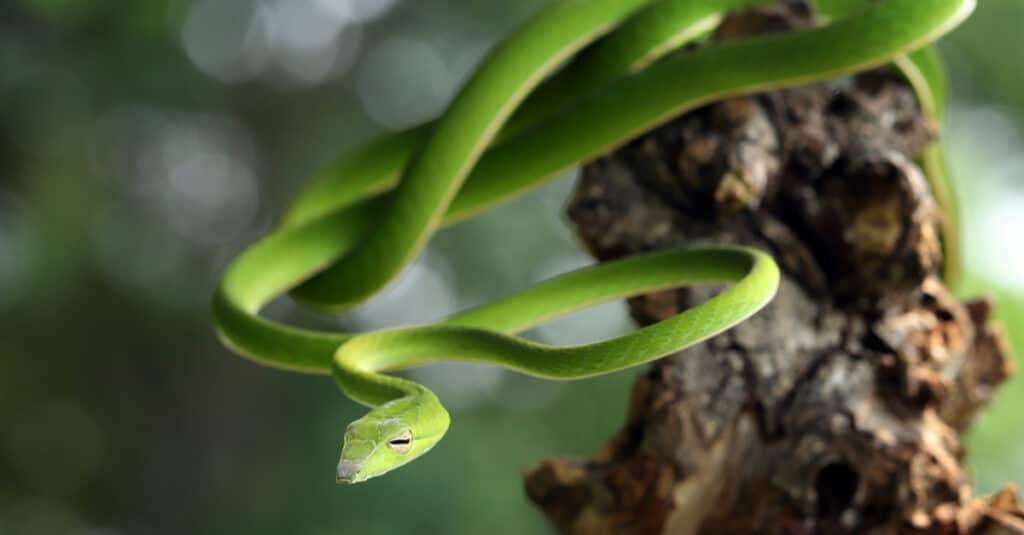
Asian vine snakes are as thin as a pencil.
©Lauren Suryanata/Shutterstock.com
Behavior
The Asian vine snake is aggressive toward its prey but has an otherwise mild temperament. It’s sometimes kept as a pet, however, keeping this snake as a pet is difficult as it requires special care in the form of a diet that includes amphibians.
Generally, these snakes don’t stray from their forest habitat where they hide among the branches of the trees.
This snake has a venomous bite, but its venom is considered mild and not dangerous to humans. This is why some people keep these snakes as pets. Of course, its venomous bite is deadly to this snake’s prey.
Though this snake is aggressive when hunting its prey, it’s only likely to bite a human if it feels threatened.
If someone gets a bite from this snake, the first step in first-aid care is to wash the wound with soap and water. Next, put first-aid ointment on the wound and cover it with a clean bandage. If there’s excessive pain, swelling, or a rash, then it’s a good idea to see a medical professional for care to check for an infection.
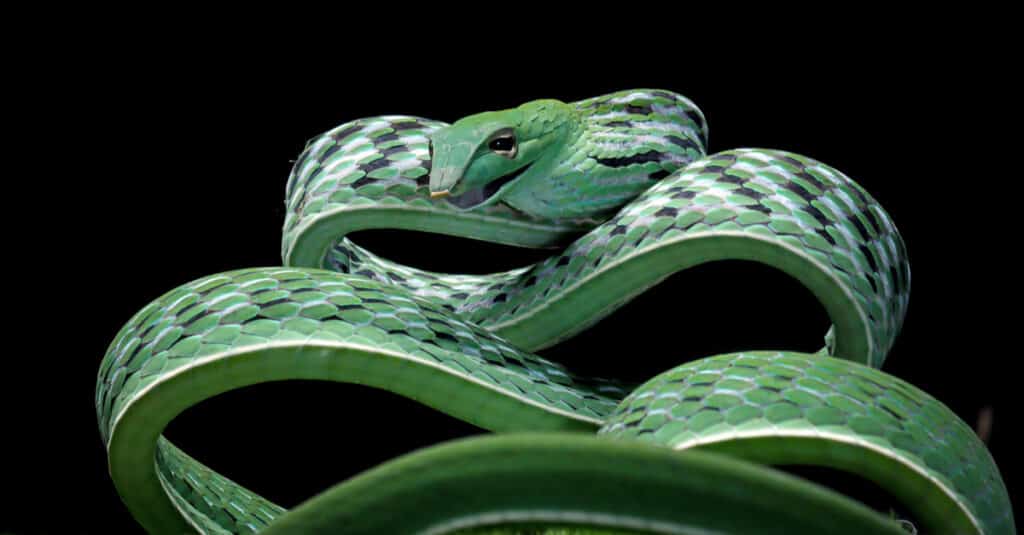
Asian vine snakes are considered to be mildly venomous.
©Kurit afshen/Shutterstock.com
Habitat
The Asian vine snake lives in Southeast Asia, with its range including the Philippines, Thailand, Vietnam, Cambodia, and Myanmar.
As its name indicates, these snakes spend a lot of time blending in with the branches of trees in forests. They live in moist or dry forests as well as in shrubland habitats. These snakes live in a tropical climate and are active throughout the year.
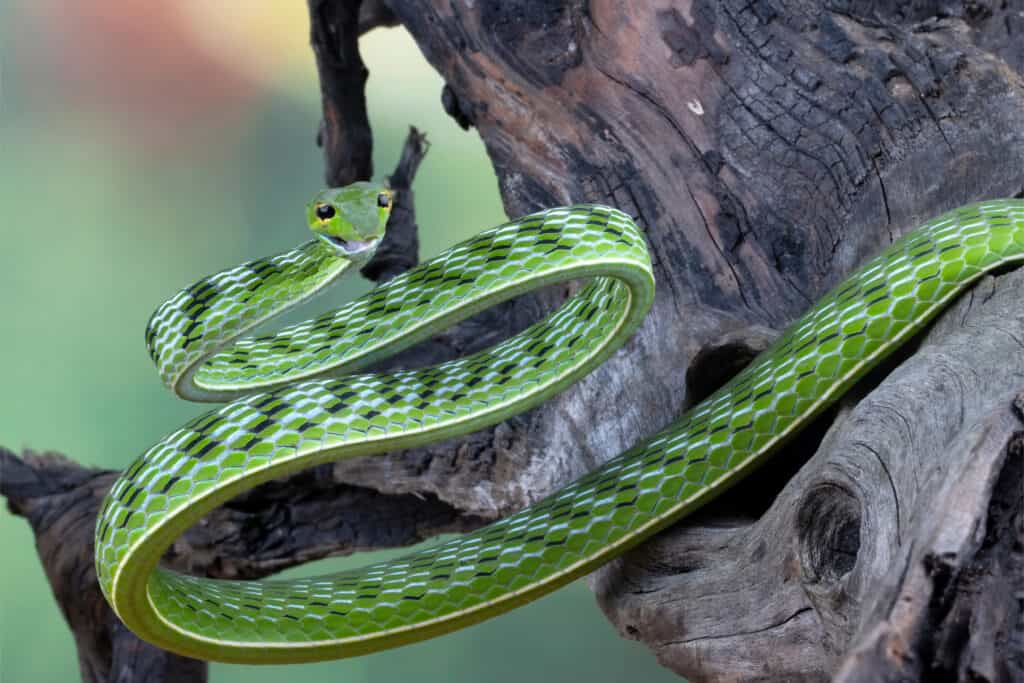
Asian vine snakes are found in forests in Southeast Asia.
©Kurit afshen/Shutterstock.com
Diet
Their main source of food is frogs, but they eat lizards and insects as well. Sometimes they eat small birds.
This snake’s narrow, green body allows it to blend in with the branches and vines of a tree. These snakes are even known to practice a swaying motion to further blend in with their forest habitat. Not surprisingly, the reptile can easily hide from lizards and other types of prey that inhabit the trees.
An Asian vine snake’s thin, narrow tongue can look a lot like a worm to a frog or a lizard. So, if this snake is on the ground moving through a swampy area in its habitat, it will use its tongue to lure a frog or toad toward it. The snake captures its prey before it has a chance to realize it is not pursuing a worm!
When it comes to capturing their food, these snakes are aggressive hunters. They aim their spear-like head at the neck of their prey. The snake strikes at its prey, grabbing it and releasing its venom. One of the most intriguing facts about this snake is it will not just strike, but chew on its prey. This chewing behavior releases more venom into the frog, lizard, or other small animals.
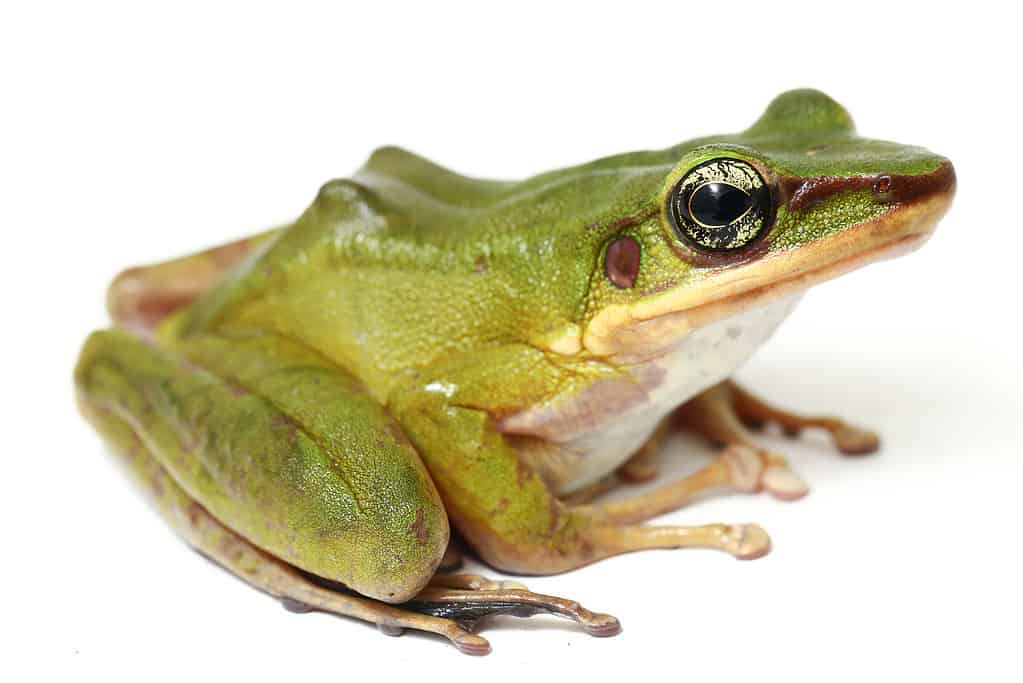
Frogs make up the majority of the Asian vine snake’s diet.
©dwi putra stock/Shutterstock.com
Predators and Threats
Humans are a big threat to Asian vine snakes because in some countries including Vietnam and China, the snakes are hunted to make snake wine, in which snakes are bottled and infused in rice wine or grain alcohol, and as part of traditional medicines. The snakes are also captured to sell as pets.
The Asian vine snake’s predators also include birds of prey, cat species, and other, larger snakes.
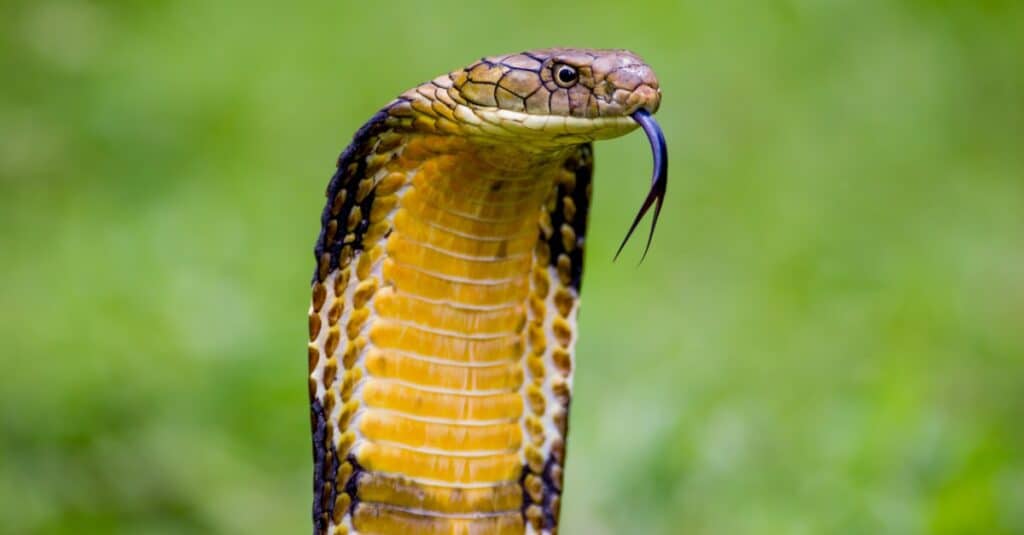
Larger snakes can prey upon Asian vine snakes.
©iStock.com/takeo1775
Reproduction, Babies, and Lifespan
At around three years old, Asian vine snakes reach sexual maturity. The breeding season occurs when the temperatures are highest in their habitats, typically late spring or early in the summer, in order to give offspring the optimal conditions for developing. A male will at times battle it out with another male over a female during mating season.
As Asian vine snakes are ovoviviparous, eggs develop within the body, and female snakes give birth to around 7-10 live young, although if they are a large size it could be up to 12 young per clutch. The snakes measure around 9.5 inches when young and when fully grown can be 2.5 to 5 feet in length.
Asian vine snakes can generally live for up to 12 years in the wild. In captivity, their average lifespan is about 8 to 12 years.
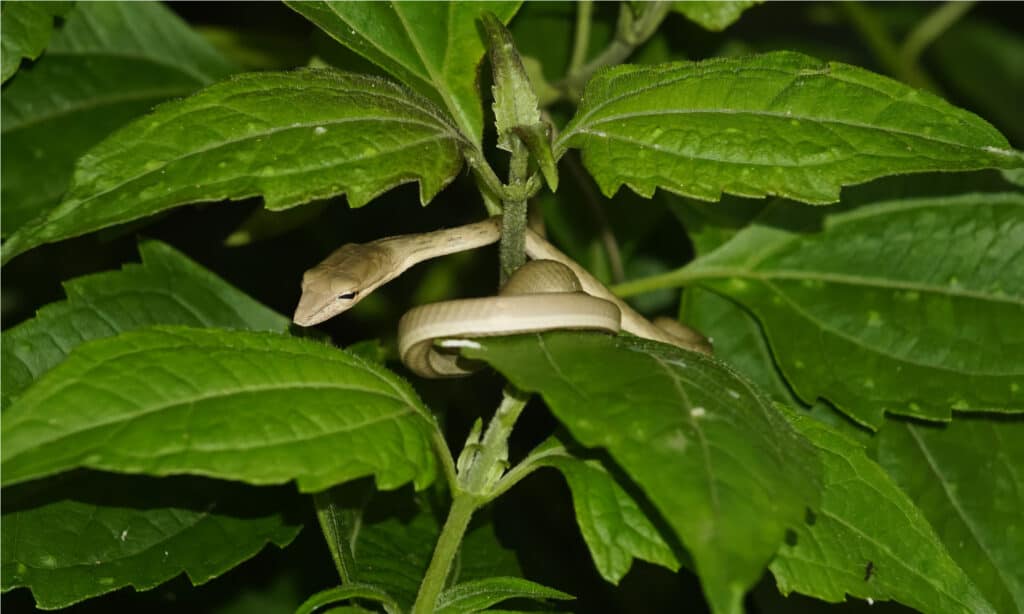
The Asian vine snake measures around 9.5 inches when young.
©Susilo Prambanan/Shutterstock.com
Population and Conservation Status
There is no population data available for the Asian vine snake, however it is described as widespread and commonplace in the Philippines and Indochina and has a stable population. The IUCN Red List of Threatened Species categorizes the Asian vine snake under Least Concern.
View all 194 animals that start with AAsian Vine Snake FAQs (Frequently Asked Questions)
Are Asian vine snakes venomous?
Yes, Asian vine snakes are venomous. Their venom is mild, so they aren’t considered a threat to humans.
How do Asian vine snakes hunt?
This snake’s narrow, green body allows it to blend in with the branches and vines of a tree. These snakes are even known to practice a swaying motion to further blend in with their forest habitat. Not surprisingly, the reptile is easily able to hide from lizards and other types of prey that inhabit the trees.
An Asian vine snake’s thin, narrow tongue can look a lot like a worm to a frog or a lizard. So, if this snake is on the ground moving through a swampy area in its habitat, it will use its tongue to lure a frog or toad toward it. The snake captures its prey before it has a chance to realize it is not pursuing a worm!
The snake strikes at its prey, grabbing it and releasing its venom. One of the most intriguing facts about this snake is it will not just strike, but chew on its prey. This chewing behavior releases more venom into the frog, lizard, or other small animal.
Are Asian vine snakes aggressive?
When it comes to capturing their food, these snakes are aggressive hunters. They aim their spear-like head at the neck of their prey. But they are not aggressive toward humans which is why some people think of this snake as a pet.
Where do Asian vine snakes live?
They live in Southeast Asia specifically in the Philippines, Thailand, Vietnam, Cambodia, and Myanmar.
They get their name from their forest habitat. This snake blends into a group of tree branches like it’s just another vine!
What do Asian vine snakes eat?
Their main source of food is frogs, but they eat lizards and insects as well. Sometimes they eat small birds.
How big do Asian vine snakes get?
An Asian vine snake can grow to 2.5 feet and as long as 5 feet.
Can Asian vine snakes kill you?
No. This snake’s bite contains a mild venom that is not harmful to humans unless someone has a specific allergy.
What other names does the Asian vine snake go by?
This snake has several other names including the Gunther’s whip snake, Oriental whip snake, and Boie’s whip snake. All of these names refer to its narrow body resembling a whip.
Thank you for reading! Have some feedback for us? Contact the AZ Animals editorial team.
Sources
- IUCN Red List / Accessed April 18, 2022
- The Living Planet / Accessed April 18, 2022
- Wikipedia / Accessed April 18, 2022
- Monaco Nature Encyclopedia / Accessed April 18, 2022
- Learn About Critters / Accessed April 18, 2022
- Thai National Parks / Accessed April 18, 2022
- Ecology Asia / Accessed April 18, 2022


















